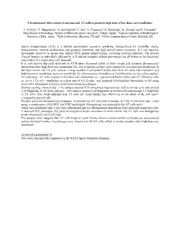
NASA Technical Reports Server (NTRS) 20110014175: Chromosomal Aberrations in Normal and AT Cells Exposed to High Dose of Low Dose Rate Irradiation PDF
Preview NASA Technical Reports Server (NTRS) 20110014175: Chromosomal Aberrations in Normal and AT Cells Exposed to High Dose of Low Dose Rate Irradiation
Chromosomal Aberrations in normal and AT cells exposed to high dose of low dose rate irradiation T. Kawata1, N. Shigematsu1, O. Kawaguchi1, C. Liu2, Y. Furusawa2, R. Hirayama2, K. George3 and F. Cucinotta4 1 Department of Radiology, School of Medicine, Keio University, Tokyo, Japan, 2 National Institute of Radiological Sciences, Chiba, Japan, 3 Wyle Laboratory, Houston, TX and 4 NASA Johnson Space Center, Houston TX Ataxia telangiectasia (A-T) is a human autosomally recessive syndrome characterized by cerebellar ataxia, telangiectases, immune dysfunction, and genomic instability, and high rate of cancer incidence. A-T cell lines are abnormally sensitive to agents that induce DNA double strand breaks, including ionizing radiation. The diverse clinical features in individuals affected by A-T and the complex cellular phenotypes are all linked to the functional inactivation of a single gene (AT mutated). It is well known that cells deficient in ATM show increased yields of both simple and complex chromosomal aberrations after high-dose-rate irradiation, but, less is known on how cells respond to low-dose-rate irradiation. It has been shown that AT cells contain a large number of unrejoined breaks after both low-dose-rate irradiation and high-dose-rate irradiation, however sensitivity for chromosomal aberrations at low-dose-rate are less often studied. To study how AT cells respond to low-dose-rate irradiation, we exposed confluent normal and AT fibroblast cells to up to 3 Gy ofγ-irradiation at a dose rate of 0.5 Gy/day and analyzed chromosomal aberrations in G0 using fusion PCC (Premature Chromosomal Condensation) technique. Giemsa staining showed that 1 Gy induces around 0.36 unrejoined fragments per cell in normal cells and around 1.35 fragments in AT cells, whereas 3Gy induces around 0.65 fragments in normal cells and around 3.3 fragments in AT cells. This result indicates that AT cells can rejoin breaks less effectively in G0 phase of the cell cycle? compared to normal cells. We also analyzed chromosomal exchanges in normal and AT cells after exposure to 3 Gy of low-dose-rate γ rays using a combination of G0 PCC and FISH techniques. Misrejoining was detected in the AT cells only? When cells irradiated with 3 Gy were subcultured and G2 chromosomal aberrations were analyzed using calyculin- A induced PCC technique, the yield of unrejoined breaks decreased in both normal and AT cells and misrejoined breaks increased in both cell lines. The present study suggests that AT cells begin to rejoin breaks when a certain number of breaks are accumulated and an increased number of exchanges were observed in G0 AT cells, which is similar situation after high-dose-rate irradiation. ACKNOWLEDGMENTS This study was partially supported by the NASA Space Radiation Program.
